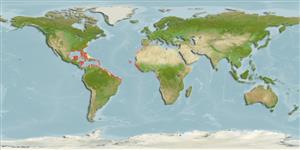Environment: milieu / climate zone / depth range / distribution range
Ecología
marino; salobre asociado a arrecife; rango de profundidad 0 - 5 m (Ref. 3723). Subtropical; 41°N - 13°S, 98°W - 14°E
Western Atlantic: New York, USA and northern Gulf of Mexico to Brazil (Ref. 7251); including the Caribbean Sea (Ref. 3723). Eastern Atlantic: from Morocco to the Canary Islands (Ref. 57227) and in the Gulf of Guinea from Victoria, Nigeria to south to Luanda, Angola (Ref. 4497). Reported from Côte d'Ivoire (Ref. 28587, 57227).
Tamaño / Peso / Age
Maturity: Lm ? range ? - ? cm
Max length : 40.0 cm TL macho / no sexado; (Ref. 3633); common length : 35.0 cm TL macho / no sexado; (Ref. 3633)
Espinas dorsales (total) : 0; Radios blandos dorsales (total) : 11 - 15; Espinas anales: 0; Radios blandos anales: 10 - 13. Diagnosis: body elongate; lower jaw forming long, narrow beak; upper jaw short, triangular and scaled; absence of scales on snout; no preorbital crest between eye and nasal pit; pelvic fins abdominal; dorsal and anal fins placed far back on body and spineless; caudal fin deeply forked (Ref. 57227).
An inshore, surface-dwelling fish which forms sizeable schools (Ref. 3723). Feeds on small fishes and plankton (Ref. 3723). Mainly used as bait for offshore game fishes such as sailfishes and marlins; utilized as a food fish in the West Indies (Ref. 3723). Minimum depth range from Ref. 84211.
Life cycle and mating behavior
Madurez | Reproducción | Puesta | Huevos | Fecundidad | Larva
Collette, B.B. and N.V. Parin, 1990. Hemiramphidae. p. 579-582. In J.C. Quero, J.C. Hureau, C. Karrer, A. Post and L. Saldanha (eds.) Check-list of the fishes of the eastern tropical Atlantic (CLOFETA). JNICT, Lisbon; SEI, Paris; and UNESCO, Paris. Vol. 2. (Ref. 4497)
IUCN Red List Status (Ref. 130435: Version 2024-1)
Threat to humans
Harmless
Human uses
Pesquerías: escaso valor comercial; carnada: usually
Herramientas
Special reports
Download XML
Fuentes de Internet
Estimates based on models
Preferred temperature (Ref.
123201): 21.1 - 28.1, mean 27.2 °C (based on 1007 cells).
Phylogenetic diversity index (Ref.
82804): PD
50 = 0.5005 [Uniqueness, from 0.5 = low to 2.0 = high].
Bayesian length-weight: a=0.00339 (0.00169 - 0.00679), b=3.09 (2.92 - 3.26), in cm total length, based on LWR estimates for this species & Genus-body shape (Ref.
93245).
Nivel trófico (Ref.
69278): 3.9 ±0.3 se; based on diet studies.
Resiliencia (Ref.
120179): Alto, población duplicada en un tiempo mínimo inferior a 15 meses (Preliminary K or Fecundity.).
Fishing Vulnerability (Ref.
59153): Low to moderate vulnerability (30 of 100).
Nutrients (Ref.
124155): Calcium = 79.2 [27.5, 252.2] mg/100g; Iron = 0.831 [0.317, 2.037] mg/100g; Protein = 19.3 [16.7, 21.8] %; Omega3 = 0.188 [0.071, 0.570] g/100g; Selenium = 15.3 [5.2, 42.4] μg/100g; VitaminA = 27.3 [5.6, 150.6] μg/100g; Zinc = 1.02 [0.54, 1.80] mg/100g (wet weight);
